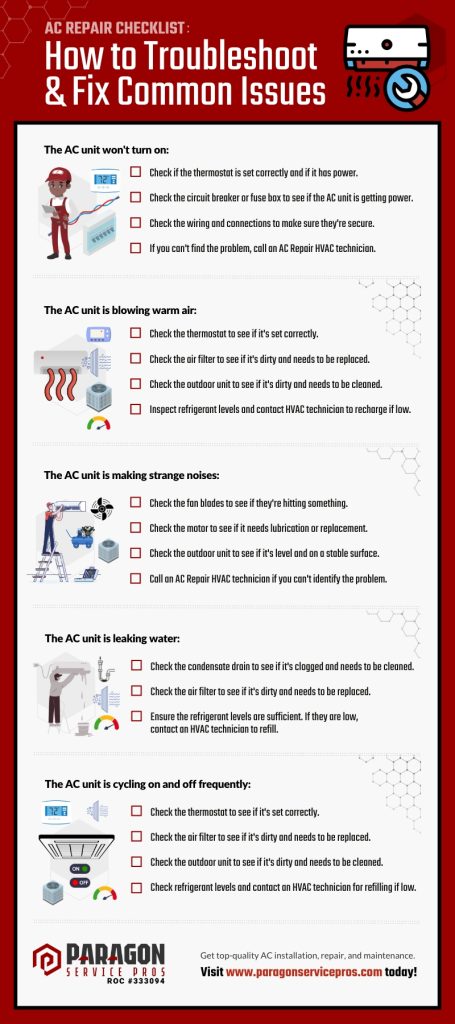Ultimate AC Repair Checklist: How to Troubleshoot & Fix Common Issues

The post Ultimate AC Repair Checklist: How to Troubleshoot & Fix Common Issues appeared first on UK Construction Blog.
As it gets hotter in the summer, a broken AC unit can make inside your home feel really uncomfortable. To prevent such situations, make sure to maintain a checklist for addressing common AC problems. In this guide, we will explore how to troubleshoot and possible solutions for prevalent issues that might trouble your air conditioning system.
The Air Conditioner Won’t Turn On
If you find your AC unit unresponsive, start by checking the thermostat settings and power supply. Make sure the thermostat is set to the right temperature and has power. If the issue persists, inspect the circuit breaker or fuse box to confirm the unit is receiving power. Inspect your air conditioning wiring and connections for any signs of loose parts. Also, examine the electrical panel for any tripped breakers or blown fuses, as they could be causing the unit’s unresponsiveness.
The AC Unit is Blowing Warm Air
If the air from your air conditioner is warm instead of the expected cool relief, start by checking the thermostat settings. A dirty air filter on your air conditioning unit can also hinder proper cooling; therefore, regular replacements are crucial. If the warm airflow issue persists, consider cleaning the outdoor unit by gently removing any debris around it.
The AC Unit is Making Strange Noises
Unusual sounds from your AC system can be unsettling. Check the fan blades to make sure they are not hitting anything. Lubricate or replace the motor if necessary. Check the outdoor unit’s level and stability, as an imbalanced unit can contribute to strange sounds.
If the noise persists even after checking and adjusting the fan blades, lubricating or replacing the motor. You can also place soft padding or rubber feet beneath the unit to minimize vibrations and potential noise from your AC unit.
The AC Unit is Leaking Water
A leaking air conditioning unit demands immediate attention. Examine the condensate drain for potential clogs and clean it if necessary. A dirty air filter may also contribute to water leakage, so be diligent in replacing it regularly. Check refrigerant levels and refill if low, as inadequate levels can lead to water accumulation. Also, check that the condensate drain is positioned correctly and that the unit is level.
The AC Unit is Frequently Cycling On and Off
Frequent cycling can strain your AC system and impact its efficiency. Begin by checking the thermostat settings and the condition of the air filter. Additionally, make sure that there are no obstructions around the outdoor unit, such as plants or debris, as these can also contribute to the frequent cycling issue. Outdoor unit cleanliness is crucial, as dirt can impede proper functioning.
When to Call in a Professional Air Conditioning Technician
There are instances when professional intervention is necessary. If you have followed the troubleshooting steps and the problem persists, it’s time to call in the experts. Complex issues like condenser or evaporator coil malfunctions or compressor problems often require specialized knowledge and equipment.
Moreover, if you do not have the necessary technical knowledge to safely address motor or wiring issues, it is safer to leave these tasks to trained HVAC technicians. Investing in professional assistance ensures a thorough diagnosis and proper resolution, preventing potential further damage. Don’t hesitate to contact an HVAC system technician when faced with persistent or intricate problems to restore your AC unit’s optimal performance.
AC Maintenance
Maintaining a well-functioning AC system requires a proactive approach to troubleshooting and resolving common issues. By following an essential checklist for fixing common AC problems, you can address issues promptly and experience a consistently cool and comfortable indoor atmosphere. If AC repair seems too complicated, consult an air conditioning repair HVAC technician for the best performance and longevity of your cooling system.
Comments are closed